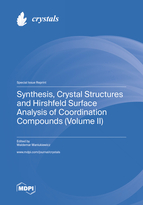Synthesis, Crystal Structures and Hirshfeld Surface Analysis of Coordination Compounds (Volume II)
A special issue of Crystals (ISSN 2073-4352). This special issue belongs to the section "Hybrid and Composite Crystalline Materials".
Deadline for manuscript submissions: closed (28 February 2023) | Viewed by 21809
Special Issue Editor
Interests: coordination chemistry; solid-state chemistry; medicinal chemistry; X-ray crystallography; solid-state synthesis; crystal engineering; molecular structure; polymorphism
Special Issues, Collections and Topics in MDPI journals
Special Issue Information
Dear Colleagues,
It is worth recalling that 125 years have passed since the pioneering work of Alfred Werner on the stereochemistry of coordination compounds, which emphasized the number and nature of the groups attached to the metal ion. These compounds are still compelling and experimentally demanding frontiers in modern inorganic chemistry. Every year we observe the emergence of scientific reports on the synthesis of new complexes with unexpected bonding modes, structures, and properties.
This Special Issue of Crystals is expected to provide an excellent platform to report results that highlight the synthesis and crystal structures of coordination compounds. Furthermore, Hirshfeld surface analysis has become a widely used method for exploring intermolecular interactions within a crystal structure in a remarkable way.
As Guest Editor, I invite scientists from various fields to submit articles which discuss the crystal chemistry of coordination chemistry. This includes examples of synthesis and experimentally determined crystal structures. New approaches to the synthesis of coordination complexes are particularly encouraged.
Dr. Waldemar Maniukiewicz
Guest Editor
Manuscript Submission Information
Manuscripts should be submitted online at www.mdpi.com by registering and logging in to this website. Once you are registered, click here to go to the submission form. Manuscripts can be submitted until the deadline. All submissions that pass pre-check are peer-reviewed. Accepted papers will be published continuously in the journal (as soon as accepted) and will be listed together on the special issue website. Research articles, review articles as well as short communications are invited. For planned papers, a title and short abstract (about 100 words) can be sent to the Editorial Office for announcement on this website.
Submitted manuscripts should not have been published previously, nor be under consideration for publication elsewhere (except conference proceedings papers). All manuscripts are thoroughly refereed through a single-blind peer-review process. A guide for authors and other relevant information for submission of manuscripts is available on the Instructions for Authors page. Crystals is an international peer-reviewed open access monthly journal published by MDPI.
Please visit the Instructions for Authors page before submitting a manuscript. The Article Processing Charge (APC) for publication in this open access journal is 2600 CHF (Swiss Francs). Submitted papers should be well formatted and use good English. Authors may use MDPI's English editing service prior to publication or during author revisions.
Keywords
- coordination complexes
- synthesis
- crystal and molecular structure
- hirshfeld surface analysis
- non-covalent interactions






